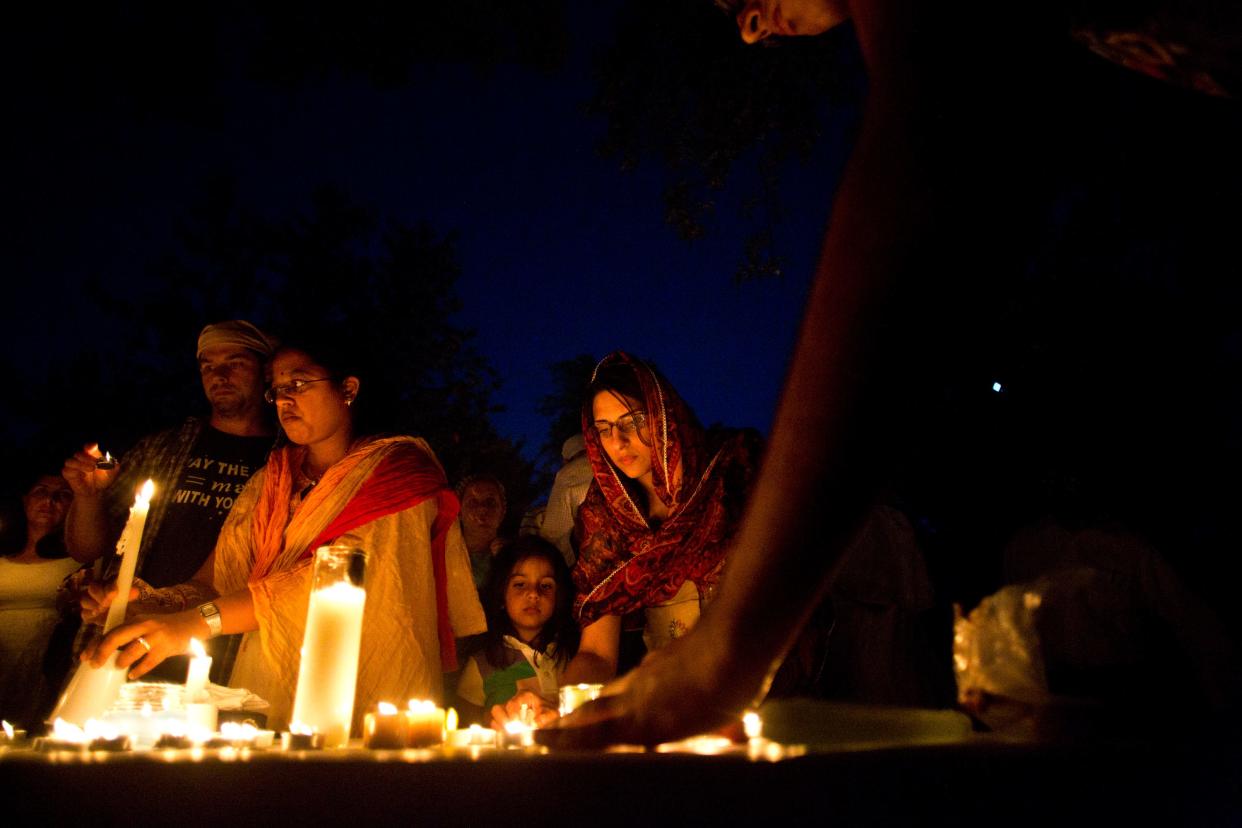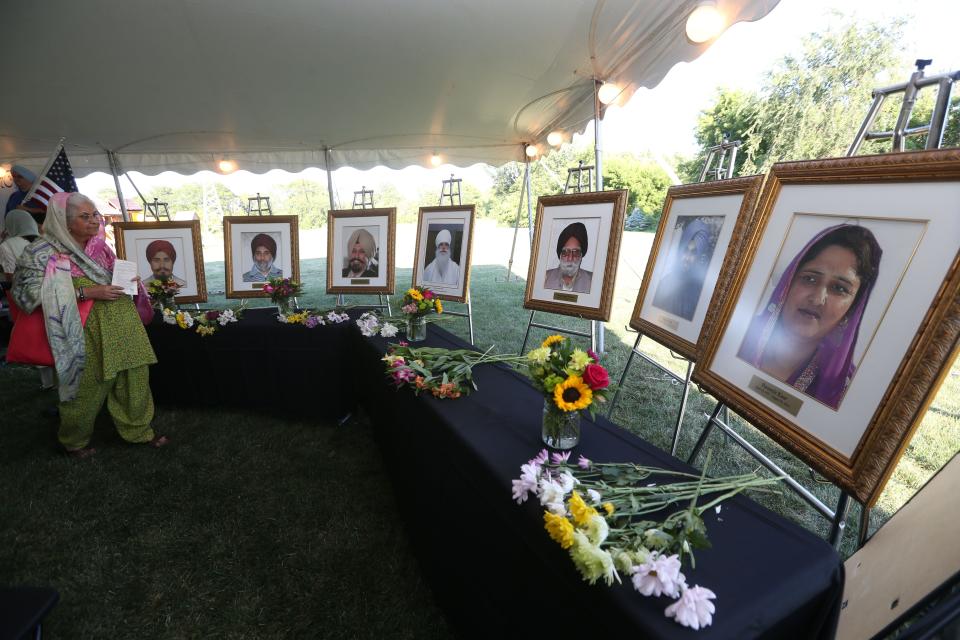These two Milwaukee-area friends turned their trauma from the 2012 Sikh Temple shooting into an inspiring play

Mohammad Shah was at a gym in Greenfield on Aug. 5, 2012 when he checked Facebook on his phone.
The workout got his heart rate up, but the news he read dropped it into the pit of his stomach.
There was an active shooter at the Sikh Temple, 7512 S. Howell Ave., in Oak Creek.
Shah grew up as a Muslim in Milwaukee and Muskego, and he had a lot of close friends who were members there. He drove directly to the temple.
The street was shut down and police were everywhere. Nobody knew if the shooter was alive, dead or maybe holding hostages.
Shah passed out water and snacks “to keep people with some kind of nutrition to handle this really stressful moment.”
He stayed on scene for about six hours and was still there when word got around the shooter was dead.
Six people lost their lives to the shooter that day — a seventh died in 2020 from complications that came from the shooting — and four others were injured.
“It was a pretty traumatic day for me,” Shah said. “There was kind of a queasy, unsettling feeling that maybe this white supremacist was trying to kill Muslims and just did not know any better about who he was actually killing.”
He said the tragedy impacted him and “the entire South Asian community” of Sikhs, Muslims, Hindus and others, very deeply. It also inspired him to share the story of the trauma with others, and he and friend have done just that.

Shah was friends with Sundeep Morrison for about decade before the Sikh Temple shooting happened.
A writer and performer in Los Angeles, Morrison, a Sikh who identifies as non-binary and uses they/them pronouns, was born in Calgary, Alberta, Canada but grew up in the Milwaukee area. They were raised by their maternal grandmother who “planted the seeds of the power of storytelling.”
“Wisconsin’s a place that’s really close to my heart,” Morrison said. “I essentially grew up there, I have family there and it’s a space that really shaped me as a person as well.”
Morrison said they were dealing with anger, fear and sadness over the 2012 shooting, calling it “a moment that changed our family and our immediate community and myself.” They were worried about the safety of their parents.
“If they’re not safe in their place of worship, where are they safe?” Morrison asked.
While their parents hailed from McFarland, Wisconsin, there are only three Sikh temples in Wisconsin, and it was a real fear Morrison's mother could have been singing hymns at the Oak Creek temple when the shooter arrived.
“I could not stop thinking about my mom and her role as she’s been such a champion of the community,” Morrison said, adding it now can be triggering to visit places of worship.
Morrison channeled these feelings, along with experiences as a child of immigrants “when the world was drastically changed” post-9/11, into a short story that became “Rag Head: An American Story.”
“I started to just wanting to purge those feelings and process it and that’s how the story came out,” Morrison said. “I write what I know.”
Morrison shared the story with friends and fellow writers who told them it had a deep message and encouraged Morrison to share it. After they formulated it into a stage play, Morrison planned to cast other actors, but a mentor encouraged them to instead pursue a solo performance.
'Moved to tears' seeing the show and getting involved
Shah flew out and attended the debut of Rag Head in L.A.
“I was ... moved to tears,” he said, adding the show explores hate, hope and American identity.
Shah could relate to the issues included in the performance stemming from the 2001 attack in New York.
“I was a sophomore in high school when Sept. 11 happened and I felt a lot of blowback from people’s trauma and the things that they experienced from that,” he said.
With a background in entertainment, Shah partnered with his friend to present the show to a bigger, wider audience. After an eight-week run in Los Angeles, and a few performances in San Diego, Morrison planned to bring Rag Head to Seattle, but the Coronavirus pandemic shut everything down.
“(It) threw a big wrench into our works,” Shah said.
There were also plans for a New York show prior to the pandemic but that was also delayed — until now.
Rag Head made its New York debut on Oct. 28 as part of the United Solo Festival. It’s the first time in three years Morrison is performing it on stage.
Are attitudes toward diversity changing?
Morrison’s biggest moment was bringing Rag Head to Wisconsin in 2019, to those who were directly affected by the 2012 tragedy.
“For me, personally, to bring it back to the community and to share the story with the community that inspired (it) was and is always going to be the biggest moment in my heart and in my artistic journey,” they said. “You want people to feel something and to walk away hopefully thinking differently.”
“It’s seven characters … I think that my common thread is each of these characters is a proud American,” Morrison said. “We all don’t think similarly, and I think that’s what makes us beautiful but to be able to receive a story and give a story a chance, I think that’s always the goal.”
Shah agreed and said in general he’s seen a shift in the right direction toward “embracing your neighbors” over the last decade.
“I personally feel that we all have far more in common than we have different from each other. It’s very important to emphasize that specific piece.” he said. “The world is moving into a place that wants to just end violence and end ignorance hoping that these kinds of tragedies won’t come up again.”
Shah said Rag Head explores those themes.
“What Sundeep’s piece is really about is understanding who Sikh people are that they’re humans who have families … and they want the same access and opportunity that everybody else wants,” he said. “A lot of immigrants that come to this country are doing it because they want to become part of the American identity.”
Who are the Sikh people?
“We celebrate anybody that comes in our door,” Morrison said. “It’s more so looking at what you have in common than the differences.”
On a personal level, Morrison said the Sikh community “has embraced me more than not.” They said as a queer non-binary artist, no matter what community you are part of, “you’re on the margin lines of the margin lines.” They said one of the main tenants of Sikhism is love, Morrison added, saying it’s “a through-line of all the teachings.”
The future for Rag Head: An American Story
Shah said there’s a desire to bring Rag Head back to Wisconsin, though there are no concrete plans. The show was last in the state in 2019 where it sold out three shows at the Broadway Theatre in the Third Ward.
The Milwaukee shows raised funds for the Interfaith Conference of Greater Milwaukee, an opportunity which came from Pardeep Singh Kaleka, whose father was killed in the 2012 temple attack. He was a co-producer for Rag Head in Milwaukee.
“With hate crimes against Sikhs and Muslims on the rise, Morrison provides a voice to one of the deadliest Hate Crimes committed against the Sikh diaspora on August 5, 2012,” Kaleka said in a quote on Morrison’s website. “Her (sic) storytelling not only pays reverence to the six lives lost that day but also resurrects the spirit of chardi kala, relentless optimism, in us all that the moral arc of the universe will always bend to the good."
Morrison is also hoping to eventually create a film version of Rag Head to reach even more people with their message of inclusion.
Contact Erik S. Hanley at erik.hanley@jrn.com. Like his Facebook page and follow him on Twitter at @ES_Hanley.
THANK YOU: Subscribers' support makes this work possible. Help us share the knowledge by buying a gift subscription.
DOWNLOAD THE APP: Get the latest news, sports and more
This article originally appeared on Milwaukee Journal Sentinel: Wisconsin Sikh Temple shooting, friendship inspired Rag Head play

